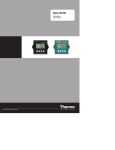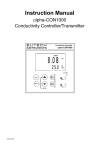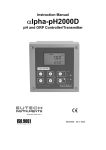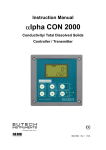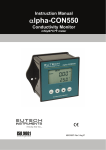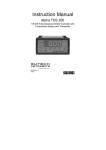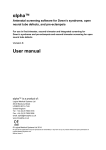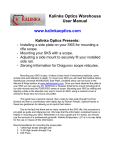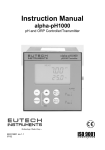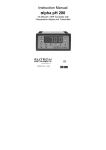Download EUTECH INSTRUMENTS ALPHA DO 500 DISSOLVED OXYGEN Instruction manual
Transcript
Instruction Manual αlpha-DO2000 Dissolved Oxygen Controller/Transmitter Technology Made Easy ... 68X216835 Rev 0 05/04 Preface This manual serves to explain the use of the αlpha DO 2000 Series. The manual functions in two ways, firstly as a step by step guide to help the user operate the instrument, and secondly as a handy reference guide. This instruction manual is written to cover as many anticipated applications of the αlpha DO 2000 as possible. If you have any doubts concerning the use of the instrument, please do not hesitate to contact the nearest Eutech Instruments Authorised Distributor. The information presented in this manual is subject to change without notice as improvements are made, and does not represent any commitment whatsoever on the part of Eutech Instruments. Eutech Instruments will not accept any responsibility for damage or malfunction of the unit due to improper use of the instrument. Copyright ©2004 All rights reserved. Eutech Instruments Pte Ltd Rev 0 05/04 Safety Information This Controller/ Transmitter shall be installed and operated only in the manner specified in the Instruction manual. Only skilled, trained or authorised person should carry out installation, setup and operation of the instrument. Before powering up the unit, make sure that power source it is connected to, is as specified in the top label. Failure to do so may result in a permanent damage to the unit. The unit has live and exposed parts inside. If it has to be opened, make sure that the power to the unit is off and disconnected. The unit is Fuse protected. In the event the fuse has to be replaced, use only those as specified in the manual. The degree of protection against electric shock will be achieved only by observance of the corresponding installation rules. TABLE OF CONTENTS 1 INTRODUCTION ....................................................................................................................................... 1 1.1 1.2 1.3 1.4 2 AT THE VERY BEGINNING ...................................................................................................................... 1 INTENDED USE ...................................................................................................................................... 1 SAFETY INTSRUCTIONS ......................................................................................................................... 2 PUTTING OUT OF SERVICE / CORRECT DISPOSAL OF THE UNIT ............................................................... 2 PRODUCT DESCRIPTION....................................................................................................................... 3 2.1 DESCRIPTION OF UNIT ........................................................................................................................... 3 2.2 MEASUREMENT AND CONTROL SYSTEM ................................................................................................ 4 2.3 UNIT OVERVIEW ................................................................................................................................... 5 2.3.1 Display Overview ............................................................................................................................ 6 2.3.2 Key functions................................................................................................................................... 6 2.3.3 LED indicators ................................................................................................................................ 7 2.3.4 Security codes.................................................................................................................................. 7 2.3.5 Menu overview ................................................................................................................................ 8 3 ASSEMBLY AND INSTALLATION ........................................................................................................ 9 3.1 3.2 4 NORMAL OPERATION.......................................................................................................................... 12 4.1 5 ENTER SETUP MODE............................................................................................................................ 17 OFFSET, SALINITY AND PRESSURE COMPENSATION (OFS) SUB-FUNCTION ......................................... 18 SETTING TEMPERATURE (SET °C°F) SUB-FUNCTION ........................................................................... 19 CONTROL RELAY A / RELAY B (SP1/SP2) SUB-FUNCTION ................................................................. 20 CONTROLLER (CNTR) SUB-FUNCTION ............................................................................................... 22 CURRENT OUTPUT 1 SUB-FUNCTION ................................................................................................... 25 CURRENT OUTPUT 2 SUB-FUNCTION ................................................................................................... 26 WASH RELAY (WASH) SUB-FUNCTION .............................................................................................. 27 CONFIGURATION (CNFG) SUB-FUNCTION .......................................................................................... 28 CALIBRATION (CAL) SUB-FUNCTION.................................................................................................. 29 RELAY MODES ....................................................................................................................................... 30 7.1 7.2 8 ENTERING CALIBRATION MODE .......................................................................................................... 13 DISSOLVED OXYGEN CALIBRATION IN MG/L OR PPM OF OXYGEN........................................................ 14 DISSOLVED OXYGEN CALIBRATION IN % SATURATION OF OXYGEN .................................................... 15 VIEW ACTUAL PROBE CONDITION ....................................................................................................... 16 SETUP MODE........................................................................................................................................... 17 6.1 6.2 6.3 6.4 6.5 6.6 6.7 6.8 6.9 6.10 7 MEASUREMENT MODE ........................................................................................................................ 12 CALIBRATION MODE ........................................................................................................................... 13 5.1 5.2 5.3 5.4 6 MOUNTING THE UNIT ............................................................................................................................ 9 CONNECTION DIAGRAM ...................................................................................................................... 10 VIEW RELAY SET POINTS ..................................................................................................................... 30 MANUAL RELAY MODE ....................................................................................................................... 31 TECHNICAL SPECIFICATIONS .......................................................................................................... 32 8.1 8.2 8.3 8.4 8.5 8.6 8.7 8.8 8.9 8.10 MEASUREMENT AND COMPENSATION................................................................................................. 32 SET-POINT AND CONTROL FUNCTION – RELAY 1 & RELAY 2 .............................................................. 32 WASH FUNCTION – WASH RELAY ...................................................................................................... 33 ALARM FUNCTION – ALARM RELAY .................................................................................................. 33 TRANSMITTER FUNCTION ................................................................................................................... 33 VOLTAGE OUTPUT & HOLD FUNCTION SWITCH ................................................................................. 34 DISPLAY ............................................................................................................................................. 34 POWER SUPPLY ................................................................................................................................... 34 ELECTRICAL DATA AND CONNECTIONS .............................................................................................. 34 MECHANICAL SPECIFICATIONS ........................................................................................................... 34 8.11 8.12 9 ACCESSORIES......................................................................................................................................... 35 9.1 9.2 10 REPLACEMENT UNIT ........................................................................................................................... 35 ASSEMBLY ACCESSORIES ................................................................................................................... 35 GENERAL INFORMATION................................................................................................................... 36 10.1 10.2 10.3 10.4 10.5 11 ELECTROMAGNETIC COMPLIANCE (EMC) SPECIFICATIONS ............................................................... 34 ENVIRONMENTAL CONDITIONS........................................................................................................... 34 WARRANTY ........................................................................................................................................ 36 PACKAGING / SCOPE OF DELIVERY ...................................................................................................... 36 RETURN OF GOODS.............................................................................................................................. 36 GUIDELINES FOR RETURNING UNIT FOR REPAIR .................................................................................. 36 MAINTENANCE AND CLEANING .......................................................................................................... 36 APPENDICES ........................................................................................................................................... 37 11.1 APPENDIX 1 – UNIT FUSE AND JUMPER SETTINGS................................................................................ 37 11.2 APPENDIX 2 – SALINITY VS TEMPERATURE (@ 760 MMHG) ............................................................... 38 11.3 APPENDIX 3 – SIMPLE EXPLANATION ON THE FUNCTION OF HYSTERESIS ............................................ 39 11.4 APPENDIX 4 – GENERAL INSTRUCTIONS CONCERNING CONTROLLER SETTING ................................... 40 11.4.1 Control characteristic of Controllers used as limit value switch ............................................. 40 11.4.2 Control characteristic of P-Controllers as proportional controller......................................... 40 11.4.3 Control characteristic of PI-Controllers as proportional integral controller.......................... 40 11.4.4 Control signal of Pulse length Controllers............................................................................... 41 11.4.5 Control signal of Pulse Frequency Controllers........................................................................ 42 11.5 APPENDIX 5 – ABBREVIATIONS USED IN MENU DISPLAYS ................................................................... 43 αlpha DO 2000 Instruction manual 1 INTRODUCTION 1.1 At the very beginning We thank you for having purchased the αlpha DO 2000. The construction of the αlpha DO 2000 employs leading edge technology and complies with safety regulations currently in force. Notwithstanding this, improper use could lead to hazards for the user or a third-party, and/or adverse effects on the plant or other equipment. Therefore, the operating instructions must be read and understood by the persons involved before work is started with the αlpha DO 2000. Eutech Instruments do not accept any liability for damage that may arise from neglecting information given in this manual. This instruction manual identifies safety instructions and additional information by means of the following symbols: This symbol draws attention to safety instructions and warnings of potential danger which, if neglected, could result in injury to persons and/or damage to property. This symbol identifies additional information and instructions which, if neglected, could lead to inefficient operation and possible loss of production. The instruction manual must always be stored close at hand, in a place accessible to all people working with the αlpha DO 2000. If you have questions, which are not or insufficiently answered in this instruction manual, please contact your supplier. They will be glad to assist you. 1.2 Intended use The αlpha DO 2000 is intended solely for dissolved oxygen and temperature measurement, as described in this instruction manual. Any other use, or use not mentioned here, that is incompatible with the technical specifications is deemed inappropriate. The operator is solely responsible for any damage arising from such use. Other prerequisites for appropriate use include: − observing the instructions, notes and requirements set out in this instruction manual. − observing all local safety regulations concerning safety at work. − observing all information and warnings in the documentation dealing with the products used together with the transmitter (housings, sensors, etc.). − observing the prescribed environmental and operational conditions. 1 αlpha DO 2000 Instruction manual 1.3 Safety intsructions The αlpha DO 2000 should be installed and operated only by personnel familiar with the transmitter and who are qualified for such work. A defective transmitter must neither be installed nor put into service. The αlpha DO 2000 must only be operated under the specified operating conditions The αlpha DO 2000 must not be repaired by the customer. The αlpha DO 2000 must only be opened to replace the unit fuse or to set the jumper for Pt100/Pt1000 temperature sensor. This work must be carried out only by personnel familiar with the transmitter and who are qualified for such work. Make sure the mains cable is separated from the power supply before opening the unit. No modifications to the αlpha DO 2000 are allowed. The manufacturer/supplier accepts no responsibility for damage caused by unauthorised modifications. The risk is borne entirely by the user. 1.4 Putting out of service / Correct disposal of the unit Putting out of service • First disconnect the unit from the mains, then undo all electrical connections. • Remove the unit from the wall / panel. Correct disposal of the unit When the transmitter is finally taken out of service, observe the local environmental regulations for correct disposal or send the transmitter to your local distributor, they will take care of proper disposal. 2 αlpha DO 2000 Instruction manual 2 PRODUCT DESCRIPTION 2.1 Description of unit The αlpha DO 2000W is used for measuring dissolved oxygen and temperature values. The dissolved oxygen values can be measured using industrial dissolved oxygen sensors. The temperature values can be measured using 2-wire / 3-wire Pt100 /Pt1000 sensors. The controller / transmitter can be used for applications such as water treatment and monitoring, galvanic-decontamination, chemical processing, food processing, clean or wastewater control and neutralization processes. This controller/transmitter has many user-friendly and safety features which include: • Push-button for calibration and sensor offset adjustment from the keypad. • Built-in non-volatile memory to ensure that calibration and other information are not erased if power supply fails. • Menu-driven program that simplifies set-up. • Automatic temperature compensation (ATC). • Manual temperature compensation setting without the ATC probe, with independent setting for calibration and process temperature. • Two galvanically isolated current outputs 0/4...20mA. • Two switching contacts as set-point relays. • 0 to 2000 seconds time delay adjustment on all relays – minimizes false alarms. • Separately adjustable high and low set-point hysteresis (dead bands) prevent chattering of relays around the set points. • Three control modes: limit controller, P controller and PI controller (P/PI controller as pulse length or pulse frequency). • Large dual display LCD for easy reading with clear multiple annunciators, alarm status, operational and error messages. • Separate alarm relay alerting you to set point limits exceeded for a certain time and if the Pt100/Pt1000 wires are broken or disconnected during the ATC function. • Wash relay. • Hold function to freeze output current (0/4...20mA) and release control relays. • LED indicators signal control activities to visually monitor transmitter status from a distance. • Protection against electromagnetic interference. • Back lit and UV light protected LC display. 3 αlpha DO 2000 Instruction manual 2.2 Measurement and control system A typical measurement system consists of: • A dissolved oxygen process transmitter • A dissolved oxygen sensor with integrated or separate temperature sensor Pt100/Pt1000. • An appropriate measurement cable • An immersion, flow or process assembly • A final control element such as pump or valve • A chart recorder αlpha DO 2000W Transmitter Chart Recorder 0/4 - 20 mA Housing and Sensors Measurement Cable 4 Power Mains (80 - 250 VAC) αlpha DO 2000 Instruction manual 2.3 Unit overview Wall mounting version 5 αlpha DO 2000 Instruction manual 2.3.1 Display Overview The LC display shows two alpha-numerical fields for parameters and measured values as well as various mode and status indicators. Mode indicators: SETUP MEAS CAL HOLD ERR 13.0 MEAS: measurement mode % SETUP: Set-up mode ppm CAL: Calibration mode mg/l Status indicator: °C °F HOLD: Unit in “HOLD” mode ATC: Visible in ATC (Automatic Temperature Compensation) mode. Not visible in the Manual Temperature Compensation mode. “ATC” flashes if the temperature probe is faulty in its ATC mode ATC ERR: Error indicator 2.3.2 Key Key functions Description Enter Calibration mode (requires access code) Enter Set-up mode (requires access code) Access sub functions (parameters) within a function group of Set-up mode Confirm (store) set-up parameters and numerical values Start/Confirm calibration in Calibration mode. Select function group in the Set-up mode. Set parameters and numerical values (if key is pressed continuously, the setting speed increases). Control the relays in MANUAL relay operation. Returns to “Measurement mode” when both keys are pressed simultaneously. Display limit values for SP1 and SP2 and settings for wash contact in AUTO relay operation. Toggle between RELAY A, RELAY B or Wash relay in MANUAL relay operation Switch from AUTO to MANUAL relay operation (requires access code) 6 αlpha DO 2000 Instruction manual 2.3.3 LED indicators Relay indicators If REL key is pressed the LED (A, B or W) indicates to which Relay (A, B or Wash) the displayed limit values refer. Relay mode indicators Auto LED lights if relay operation is set to automatic mode. Manu LED lights if relay operation is set to manual mode. Relay status indicators This LED lights if limit value is exceeded or the ATC probe fails. This LED lights green if measured value is within the limit for Relay A or lights red if measured value exceeds limit. This LED lights green if measured value is within the limit for Relay B or lights red if measured value exceeds limit. This LED lights if cleaning cycle is on. 2.3.4 Security codes The access to Calibration mode, Setup mode and Manual relay operation mode is protected with security codes. The security codes are set at the factory and cannot be changed by the user. The following security codes are used: Security code Mode Description 000 View only mode to view actual settings 11 Calibration mode to start calibration 22 Setup mode to configure parameters 22 Manual relay operation to switch relay operation mode from automatic to manual 7 αlpha DO 2000 Instruction manual 2.3.5 Menu overview MEAS 13.0 % °C 4 CAL ENTER ENT 1 2 1 ENTER ENT CCD “000” = Check calibration parameters (View only mode) CCD “11” = Calibration mode SCD “000” = Check setup parameters (View only mode) SCD “22” = Setup mode 2 ENTER ENT SETUP HOLD OFS ENT Pressure Compensation settings see section 6.2 SETUP HOLD SETUP HOLD SETUP HOLD SETUP ENT ENT ENT ENT HOLD SETUP HOLD SETUP HOLD SETUP HOLD Relay B (set point 2) settings see section 6.4 Controller settings see section 6.5 Current output 1 settings see section 6.6 ENT Current output 2 settings see section 6.7 ENT Wash contact settings see section 6.8 ENT HOLD SETUP Relay A (set point 1) settings see section 6.4 ENT HOLD SETUP Temperature settings see section 6.3 ENT 8 Unit settings see section 6.9 Calibration see section 6.10 αlpha DO 2000 Instruction manual 3 ASSEMBLY AND INSTALLATION 3.1 Mounting the unit Wall mounting version 111.50 [4.39] 144 [5.67] ] 7 6 5 [ 4 4 1 27.5 [1.08] . ] 5 5 [ 4 1 xo p p a . . r For Pg13.5 cable glands 24 [.94] 39 [1.54] Pg13.5 (3 pcs.) 78 [3.07] 57.8[2.28] 80 [3.15] ]2 6 2 [ 5 6 6 ]5 8 [ 5 1 2 Holes for post mounting (4X) . . . Holes for wall mounting (2X) . ] 4 5 3 [ 0 9 6 [.24] . Unit: MM [INCH] 90 [3.54] Transmitter housing for wall mounting: protection class IP 65 9 αlpha DO 2000 Instruction manual 3.2 Connection Diagram Caution: Ensure electrical mains are disconnected before proceeding. Fuse: 250V 315 mA Time Delay Current OP2 13 250 V 315 mA Time Delay Current OP1 Current OP2 13 14 15 1 2 L N 16 Current OP1 14 15 1 2 L N 16 PT100/ PT1000 HOLD 17 18 19 20 21 22 3 23 4 24 26 25 6 5 7 27 8 28 29 9 30 31 10 32 11 18 3 19 20 12 PT100/ PT1000 HOLD 17 33 21 22 23 24 4 26 25 6 5 7 27 8 28 29 9 30 31 10 32 11 33 12 Connections for wall mounting version 1. 2. 3. 4. 5. 6. 7. 8. 9. 10. 11. 12. 13. 14. 15. 16. 17. AC mains live wire AC mains neutral wire AC mains protective earth wire Relay A (SP 1) Relay A (SP 1) Relay B (SP 2) Relay B (SP 2) Wash relay Wash relay Alarm relay (NC) Alarm relay common Alarm relay (NO) 4-20 mA temperature output, +ve terminal 4-20 mA temperature output, -ve terminal 4-20 mA DO output, +ve terminal 4-20 mA DO output, -ve terminal 12V output ground 18. 19. 20. 21. 22. 23. 24. 25. 26. 27. 28. 29. 30. 31. 32. 33. 12V output Power supply Hold Function Hold Function Earth ground no connection no connection no connection no connection no connection no connection Temperature ground Temperature Sense Temperature Input (Short to terminal 29 if using 2- wire RTD) no connection DO input, Cathode, -ve terminal DO input, Anode, +ve terminal IMPORTANT: The Alarm relay functions as an “Active Low” device i.e. it switches OFF under Alarm condition. Therefore the Alarm display device should be connected to the ‘NC’ contacts of the relay (10 & 11). 10 αlpha DO 2000 Instruction manual NOTE: a) Switch or circuit breaker shall be included in the building installation. b) It shall be in close proximity to the equipment and within easy reach of the operator. c) It shall be marked as the disconnecting device for the equipment. 11 αlpha DO 2000 Instruction manual 4 NORMAL OPERATION 4.1 Measurement mode When the controller/transmitter is powered on, the display first shows all segments briefly, after which the controller/transmitter automatically enters into the Measurement mode. Please note: To guarantee accurate readings the measuring system (transmitter and sensor) must be calibrated. MEAS % 13.0 °C ATC The mode indicator “MEAS” at the top of the display indicates that the transmitter is in Measurement mode. The upper alpha-numerical display shows the measured dissolved oxygen value, while the lower display shows the temperature value. From Measurement mode you can access Calibration mode and Setup mode by pressing the CAL key or ENT key followed by the corresponding security code. For detailed information refer to section 5 “Calibration mode” or section 6 “Setup mode”, respectively. By pressing the REL key in Measurement mode you can view the actual relay set points. By pressing the MODE key followed by the corresponding security code in Measurement mode you can switch relay operation mode from automatic to manual. For detailed information refer to section 7 “Relay Modes”. 12 αlpha DO 2000 Instruction manual 5 CALIBRATION MODE You can access the Calibration mode directly from the Measurement mode by pressing the CAL key and entering the Calibration security code “11”. Calibration mode may also be accessed via the Setup mode (see section 6.1). 5.1 Entering Calibration mode MEAS 13.0 % °C 4 CAL 11 ENT ENTER ENT 22 ENT SETUP HOLD SETUP HOLD OFS CAL DO Pressure Compensation Setting ENT 1-point or 2-point Calibration See section 5.2 1. While in Measurement mode press the CAL key (direct access) or ENT key (access via Setup mode). 2. If CAL key was pressed: The display prompts you to enter the calibration security code. Press the ▲ or ▼ key to set the calibration security code to “11”, and then press the ENT key to confirm the calibration security code. 3. If ENT key was pressed: The display prompts you to enter the security code. Press the ▲ or ▼ key to set the security code to “22”. Press the ENT key to confirm the security code, and then press the ▲ or ▼ key to select the calibration sub-function. The display shows “CAL DO”. To start calibration, refer to section 5.2. Note: to exit Calibration mode at any time press the ▲ and ▼ keys simultaneously (escape). The transmitter returns to the Measurement mode and the old calibration values remain active. The calibration security code automatically resets from “11” to “000” after the transmitter returns to Measurement mode. Note: The calibration is always carried out in the units (mg/l or ppm or %) selected in setup mode. The DO controller/transmitter allows a 1-point or 2-point calibration. 13 αlpha DO 2000 Instruction manual 5.2 Dissolved oxygen Calibration in mg/l or ppm of oxygen If the unit of measure is in mg/l (default) or ppm, then the calibration is also carried out in mg/l or ppm. This transmitter features a one-point or two-point calibration for dissolved oxygen. Displayed value should be within +/- 50 % of high point SETUP HO LD CAL ENT SETUP HO LD DO 1-PT ENT CAL READY HO LD HI HO LD mg/l 8.24 CAL CAL ENT 1.00 24.5 ENT ENT o C CAL MEAS 8.24 24.5 mg/l o C ATC ENT SETUP HO LD 2-PT CAL ENT CAL READY HO LD Lo ENT mg/l 0.30 Displayed value should be < 10% of high point CAL HO LD ERR CAL ENT ERR Calibration error occurs if calibration value is > 10% or > +/- 50% of high point during 1 or 2 point calibration 4. Enter Calibration mode as described in section 5.1. The display shows “CAL DO”. 5. Press the ENT key to start calibration. The display shows “1-PT CAL” by default. Use ▲ or ▼ keys to select one point “1-PT CAL” or two point “2-PT CAL” dissolved oxygen calibration. 6. Press the ENT key to confirm the one point or two points selection. 7. For One-Point Calibration, only Hi-value calibration is possible. The probe is allowed to equilibrate in a solution containing 8.24 mg/l of dissolved oxygen. The “CAL” indicator flashes at the top. When reading is stable, the “READY” annunciator comes on. Use ▲ or ▼ keys to adjust the displayed value to the correct value. Press the ENT key to accept the value and the controller displays the status of the probe. Note: If the displayed value is not within ±50% of the high point value, the controller will not accept the high-level calibration and retains the previous calibration values. Note: If there is a calibration error, the controller displays “CAL ERR” and exits to the measurement mode (for direct access calibration mode) or to the setup menu (for calibration mode accessed via Setup mode). 8. For Two-Point Calibration, calibration is carried out at the Lo-value first, usually zero oxygen solution. Immerse the probe in the solution (low levels of dissolved oxygen) and allow it to stabilize. The “CAL” indicator flashes at the top. When the reading is stable, the “READY” annunciator comes on. Press the ENT key to accept the value. Note: If the displayed value is < 10% of high point, the controller will accept the zero calibration (0.00 mg/l or ppm) and switches to the second point. Note: If the displayed value is > 10% of high point, the controller will not accept the zero calibration and retains the previous calibration values. Note: If there is a calibration error, the controller displays “CAL ERR” and exits to the measurement mode (for direct access calibration mode) or to the setup menu (for calibration mode accessed via Setup mode). 9. If the calibration is successful, the controller switches to the second point, which is the highlevel of dissolved oxygen. Take the probe out of the zero oxygen solution and immerse it in a solution with a higher concentration of dissolved oxygen. The “CAL” indicator flashes at the top. When the reading is stable, “READY” annunciator comes on. Use ▲ or ▼ keys to adjust the 14 αlpha DO 2000 Instruction manual displayed value to the correct value. Press the ENT key to accept the value and the status of the probe is displayed. Note: If the displayed value is not within ±50% of the high point value, the controller will not accept the high-level calibration and retains the previous calibration values. Note: If there is a calibration error, the controller displays “CAL ERR” and exits to the measurement mode (for direct access calibration mode) or to the setup menu (for calibration mode accessed via Setup mode). 10. After calibration, the controller automatically displays the condition of the probe in the upper display and the temperature in the lower display. You can view these values without calibration --- see Section 5.4 for instruction. The probe condition is re-determined after each calibration. 11. Press the ENT key (or CAL key) to return to the measurement mode (for direct access calibration mode) or to the setup menu (for calibration mode accessed via Setup mode). Note: When calibrating with manual temperature compensation, the controller automatically changes from the preset process temperature to the calibration temperature. After leaving the Calibration mode, the controller switches back to process temperature (for setting the calibration temperature and the process temperature, see Section 6.3) 5.3 Dissolved oxygen Calibration in % saturation of oxygen A one-point calibration is done in air. When you carry out a two-point calibration, you need a standard D.O. buffer solution that matches the low value, which is 0%. This transmitter features a one-point or two-point calibration for dissolved oxygen. Displayed value should be within +/- 50 % of high point SETUP HO LD CAL ENT SETUP HO LD DO 1-PT ENT SETUP READY HO LD CAL CAL 90.0 % CAL ENT HO LD 100.0 1.00 24.5 ENT ENT o C CAL MEAS 100.0 24.5 % o C ATC ENT SETUP HO LD 2-PT CAL ENT SETUP READY HO LD CAL 2.00 % ENT 0.0 Displayed value should be < 10% of high point SETUP HO LD ERR CAL CAL ENT ERR Calibration error occurs if calibration value is > 10% or > +/- 50% of high point during 1 or 2 point calibration 1. Enter Calibration mode as described in section 5.1. The display shows “CAL DO”. 2. Press the ENT key to start calibration. The display shows “1-PT CAL” by default. Use ▲ or ▼ keys to select one point “1-PT CAL” or two point “2-PT CAL” dissolved oxygen calibration. 3. Press the ENT key to confirm the one point or two points selection. 4. For One-Point Calibration, only calibration at the 100% level is possible. The probe is allowed to equilibrate with air. The “CAL” indicator flashes at the top. When reading is stable, the “READY” annunciator comes on. Press the ENT key to accept the high level calibration (100%) and the controller displays the status of the probe. Note: If the displayed value is not within ±50% of the high point value, the controller will not accept the high-level calibration and retains the previous calibration values. 15 αlpha DO 2000 Instruction manual Note: If there is a calibration error, the controller displays “CAL ERR” and exits to the measurement mode (for direct access calibration mode) or to the setup menu (for calibration mode accessed via Setup mode). 5. For Two-Point Calibration, calibration is carried out at 0% saturation first. Immerse the probe in zero oxygen solution and allow it to stabilize. The “CAL” indicator flashes at the top. When the reading is stable, the “READY” annunciator comes on. Press the ENT key to accept the zero calibration (0%). Note: If the displayed value is > 10% of the high point value, the controller will not accept the zero calibration and retains the previous calibration values. Note: If there is a calibration error, the controller displays “CAL ERR” and exits to the measurement mode (for direct access calibration mode) or to the setup menu (for calibration mode accessed via Setup mode). 6. If the calibration is successful, the controller switches to the second point, which is the 100% saturation of dissolved oxygen. Take the probe out of the zero oxygen solution, rinse in clean water, dry it and then calibrate in air. The “CAL” indicator flashes at the top. When the reading is stable, “READY” annunciator comes on. Press the ENT key to accept the high-level calibration (100%) and the status of the probe is displayed. Note: If the displayed value is not within ±50% of the high point value, the controller will not accept the high-level calibration and retains the previous calibration values. Note: If there is a calibration error, the controller displays “CAL ERR” and exits to the measurement mode (for direct access calibration mode) or to the setup menu (for calibration mode accessed via Setup mode). 7. After calibration, the controller automatically displays the condition of the probe in the upper display and the temperature in the lower display (for Two-Point calibration only). You can view these values without calibration --- see Section 5.4 for instruction. The probe condition is redetermined after each calibration. 8. Press the ENT key (or CAL key) to return to the measurement mode (for direct access calibration mode) or to the setup menu (for calibration mode accessed via Setup mode). Note: When calibrating with manual temperature compensation, the controller automatically changes from the preset process temperature to the calibration temperature. After leaving the Calibration mode, the controller switches back to process temperature (for setting the calibration temperature and the process temperature, see Section 6.3) 5.4 View actual probe condition MEAS 89.5 % 24.5 ATC CAL 000 ENT 1.00 C.CD 24.5 ENT o C CAL MEAS 89.5 % o C 24.5 ATC 1. While in Measurement mode press the CAL key. The display will prompt you to enter a security code. Leave the security code at “000” (view only mode). 2. Press the ENT key. The display shows the actual probe condition. 3. Press the ENT key to return to the Measurement mode. 16 αlpha DO 2000 Instruction manual 6 SETUP MODE 6.1 Enter Setup mode In the Setup mode the transmitter can be configured to your individual requirements. 1. While in Measurement mode press the ENT key. 2. The display prompts you to enter the security code. Set the security code with ▲ or ▼ key to: − “SCD 22” if you want to change parameter settings − “SCD 000” if you want to view only parameter settings (view only mode) 3. Press the ENT key ME AS 13.0 % °C ENTER ENT ENT ENTER SE TUP HOLD OFS SE TUP ENT ENT HOLD SE TUP ENT HOLD SE TUP ENT HOLD SE TUP ENT HOLD SE TUP ENT HOLD SE TUP ENT HOLD SE TUP ENT HOLD SE TUP ENT HOLD SE TUP ENT HOLD DO Offset Pressure compensation settings Temperature settings see section 6.3 Relay A (set point 1) settings see section 6.4 Relay B (set point 2) settings see section 6.4 Controller settings see section 6.5 Current output 1 settings see section 6.6 Current output 2 settings see section 6.7 Wash contact settings see section 6.8 Unit settings see section 6.9 Calibration see section 5 Note: Note: to exit Setup mode at any time press the ▲ and ▼ key simultaneously (escape). The transmitter returns to the Measurement mode. 17 αlpha DO 2000 Instruction manual 6.2 Offset, Salinity and Pressure compensation (OFS) sub-function This mode allows you to change the offset parameter to make reading corrections without removing the electrode from the control system. You can make adjustments of up to ±2.00ppm; ±2.00 mg/l; or ±10.0%. At the end of the offset adjustment, the salinity value, followed by the pressure values (in mmHg or Pascal or PSI) respectively, is entered. SETUP SETUP OFS HOLD HOLD 0.03 ENT SETUP HOLD mg/l 0.0 H9 HOLD ENT HOLD H9 PRES ENT ENT SETUP HOLD SETUP 0.03 ENT SETUP SETUP SAL 8.23 HOLD ENT ppt SETUP YES HOLD OFS mg/l BAR ENT SETUP HOLD PRES 1.013 ENT BAR OFS This page will be skipped if offset is equal to zero. ENT ENT SETUP HOLD SETUP NO PSI HOLD OFS ENT SETUP 13.00 ENT HOLD PRES PSI 1. Select the “OFS” sub-function, and then press the ENT key. 2. Press the ▲ or ▼ key to select “NO” or “YES” for offset adjustment. Select “NO” and Press the ENT key to skip offset adjustment and set salinity value. Select “YES” and Press the ENT key to do offset adjustment. 3. Selecting offset value for the dissolved oxygen: The SETUP annunciator appears at the top of the display. The lower display shows the current measured Dissolved Oxygen with its respective units. The upper display shows the current offset value. Press the ▲ or ▼ key to set the required offset. Press the ENT key to accept the offset value. Note: The offset value is reset during full calibration (See section 5). 4. Setting the Salinity Value: the upper display shows the “salinity value” in ppt, while the lower display shows “SAL”. Press the ▲ or ▼ key until the salinity value (between 0.0 ppt and 50.0 ppt, factory setting: 0.0 ppt) coincides with the correct salinity value. Press the ENT key to confirm the Salinity value. Note: This function is not available in the “%” mode and this window is not displayed. 5. Setting the pressure value (mmHg or Pascal or PSI): The upper display shows “mmHg” and the lower display shows “PRES”. Press the ▲ or ▼ key to select the unit of pressure mmHg or BAR or PSI. Press the ENT key to accept the unit of pressure. Use the ▲ or ▼ keys to set the correct pressure. Press the ENT key to confirm the pressure value. Continue with additional Setup procedures, or return to the Measurement mode by pressing the ▲ and ▼ key (escape) simultaneously. 18 αlpha DO 2000 Instruction manual 6.3 Setting temperature (Set °C°F) sub-function SETUP HOLD ENT SETUP ENT HOLD SETUP ENT HOLD SETUP ENT HOLD SETUP ENT HOLD °C ATC SETUP SETUP HOLD HOLD ENT SETUP ATC ENT HOLD °F °C ATC 1. Select the “SET °C°F” sub-function, then press the ENT key. 2. Selecting temperature unit: press the ▲ or ▼ key to select the desired temperature unit “°C” or “°F”. Press the ENTER key to confirm your selection. 3. Enable/disable ATC mode: press the ▲ or ▼ key to enable (ATC ON) or disable (ATC OFF) automatic temperature compensation. Press the ENT key to confirm your selection. − ATC disabled (ATC OFF): For manual temperature compensation you can set the process and calibration temperatures. This allows calibration at a temperature other than the process temperature. Example: setting a calibration temperature of 25°C lets you calibrate using standard solutions at 25°C, even if your process temperature is different from 25°C. 4. Setting the process temperature: press the ▲ or ▼ key to adjust the process temperature (upper value, setting range: –10.0 to 125.0°C / 14.0 to 257.0 °F). Press the ENT key to confirm process temperature. 5. Setting the calibration temperature: press the ▲ or ▼ key to adjust the calibration temperature (upper value, setting range: – 10.0 to 125.0°C / 14.0 to 257.0 °F). Press the ENT key to confirm the calibration temperature. − ATC enabled (ATC ON): 6. Setting the temperature offset: The display shows the current temperature offset (upper value) and the temperature currently measured (lower value). Compare the current temperature displayed on the transmitter to a thermometer known to be accurate. Note the correct temperature value. Press the ▲ or ▼ key to adjust the lower value. The upper number indicates the offset value. You can offset the temperature by up to ±10°C/±18°F. Press the ENT key to confirm your setting. Continue with additional Setup procedures, or return to the Measurement mode by pressing the ▲ and ▼ key (escape) simultaneously. 19 αlpha DO 2000 Instruction manual 6.4 Control Relay A / Relay B (SP1/SP2) sub-function The SP1 sub-function determines the operating parameters for Relay A; while SP2 defines the operating parameters for Relay B. Since these groups have the same set-up parameters, they are described together. SETUP HOLD ENT SETUP HOLD 90.0 % ENT SETUP ENT HOLD SETUP HOLD 2.0 % ENT SETUP HOLD ENT SETUP HOLD SETUP HOLD 1. Select the “SP1” (Relay A) or “SP2” (Relay B) sub-function, then press the ENT key. 2. Setting set point value: press the ▲ or ▼ key to enter the value for set point 1 (set point 2) at which your controller will activate. Press the ENT key to confirm your setting. 3. Selecting relay function: press the ▲ or ▼ key to select the desired relay function (“LO”= low or “HI”= high). Press the ENT key to confirm your selection. Note: Note: This parameter lets you choose the relay function. Select “LO” to activate the relay when the dissolved oxygen value undershoots the set point; select “HI” to activate the relay when the value overshoots the set point. SP1 and SP2 can be selected as “Lo/Lo”, “Lo/Hi”, “Hi/Lo”, or “Hi/Hi”. 4. Setting a hysteresis value: press the ▲ or ▼ key to select the desired hysteresis (setting range: 1 to 10% or 0.1 to 1.0 mg/l) for set point 1 (set point 2). Press the ENT key to confirm your setting. Note: Hysteresis prevents rapid contact switching if your value is fluctuating near the set point. Please refer to Appendix 3 for a graphical representation of the hysteresis. Example: You have set your high set point at 90 % and your hysteresis value is 2 %. If your measured value overshoots 90 %, the controller’s relay activates. The actions of the external device will cause the solution’s dissolved oxygen percentage saturation to drop. The relay will deactivate, when the dissolved oxygen percentage saturation value drops below 88 %. 20 αlpha DO 2000 Instruction manual 5. Setting the on-delay time lag: press the ▲ or ▼ key to enter the on-delay time for set point 1 (set point 2). The controller will delay activation of the relay for the number of seconds (0 to 2000 seconds) you select. Press the ENT key to confirm your setting. Note: You can set a time delay for each relay, which stops the relay from switching on the moment the set point is exceeded. This controller lets you set a 0 to 2000 seconds time delay before your relay activates. 6. Setting the off-delay time lag: press the ▲ or ▼ key to enter the off-delay time for set point 1 (set point 2). Your controller will delay deactivation of the relay for the number of seconds (0 to 2000 seconds) you select. Press the ENT key to confirm your setting. Note: You can set a time delay for each relay, which stops the relay from switching off the moment the value reaches the set point and hysteresis. This controller lets you set a 0 to 2000 seconds time delay before your relay deactivates. Continue with Setup mode procedures, or return to Measurement mode by pressing the ▲ and ▼ keys simultaneously (escape). 21 αlpha DO 2000 Instruction manual 6.5 Controller (CNTR) sub-function The CNTR sub-function determines the controller’s parameters. SETUP HOLD ENT SETUP ENT HOLD SETUP ENT HOLD SETUP ENT HOLD SETUP HOLD SETUP ENT HOLD SETUP ENT HOLD SETUP HOLD ENT SETUP HOLD SETUP ENT HOLD SETUP HOLD ENT SETUP HOLD SETUP % HOLD SETUP HOLD % ENT ENT SETUP ENT HOLD SETUP ENT HOLD 22 SETUP HOLD ENT SETUP HOLD ENT αlpha DO 2000 Instruction manual 1. Select the “CNTR” subfunction, then press the ENT key. 2. Selecting the controller type: press the ▲ or ▼ key to select the suitable controller type: − OFF = controller off Use control Off to operate controller as a monitor only or to prevent relays from switching. − L.CT = limit value control (on/off control). Use limit control with pumps or valves for fast response − P/PI = proportional/integral control Use proportional control to operate your pumps smoothly or for precise control of proportioning valves. Use PI controller to eliminate steady state error. Note: please refer to Appendix 4 for detailed information on controller settings. Press the ENT key to confirm your selection. − If the controller is set to limit value control (L.CT): 3. Selecting the relay status under Non-Alarm condition: press the ▲ or ▼ key to choose the desired relay status (de-energized = “DEEN” or energized = “EN”). Press the ENT key to confirm your selection. − If the controller is set to proportional control (P/PI): 4. Selecting the proportional controller type: press the ▲ or ▼ key to select the suitable controller type (“PLC” = pulse length control, “PFC” = pulse frequency control). Press the ENT key to confirm your selection. − If the proportional controller type is set to pulse length control (PLC): 5. Selecting the relay status under Non-Alarm condition: press the ▲ or ▼ key to choose the desired relay status (de-energized = “DEEN” or energized = “EN”). Press the ENT key to confirm your selection. 6. Setting the proportional range: Press the ▲ or ▼ key to set the proportional range (setting range: 10 to 500%). Press the ENT key to confirm your setting. 7. Setting the pulse length: Press the ▲ or ▼ key to set the pulse length (setting range: 0.5 to 20 seconds). Press the ENT key to confirm your setting. 8. Setting the integral action time: Press the ▲ or ▼ key to set the integral action time (setting range: 0.0 to 999.9 minutes). Press the ENT key to confirm your setting. 23 αlpha DO 2000 Instruction manual − If the proportional controller type is set to pulse frequency control (PFC): 9. Selecting the relay status under Non-Alarm condition: press the ▲ or ▼ key to choose the desired relay status (de-energized = “DEEN” or energized = “EN”). Press the ENT key to confirm your selection. 10. Setting the proportional range: press the ▲ or ▼ key to set the proportional range (setting range: 10 to 500%). Press the ENT key to confirm your setting. 11. Setting the pulse frequency: press the ▲ or ▼ key to set the pulse frequency (setting range: 60 to 120 pulses per minute). Press the ENT key to confirm your setting. 12. Setting the integral action time: press the ▲ or ▼ key to set the integral action time (setting range: 0.0 to 999.9 minutes). Press the ENT key to confirm your setting. Continue with Setup mode procedures, or return to Measurement mode by pressing the ▲ and ▼ keys simultaneously (escape). 24 αlpha DO 2000 Instruction manual 6.6 Current Output 1 sub-function In this subfunction you set the current output range of the transmitter for dissolved oxygen values. SETUP HOLD ENT SETUP HOLD ENT SETUP % HOLD ENT SETUP HOLD 90.0 % ENT SETUP HOLD ENT ENT SETUP HOLD SETUP ENT % HOLD ENT SETUP HOLD 90.0 % SETUP HOLD 1. Select the “CUR.1” subfunction, then press the ENT key. 2. Selecting the output type: press the ▲ or ▼ key to select the desired output type: 0-20 mA or 4-20 mA. Press the ENT key to confirm your selection. 3. Setting the dissolved oxygen value at which the transmitter output will be 4 mA (or 0 mA): press the ▲ or ▼ key to set the dissolved oxygen value to be equivalent to 4 mA or 0 mA, respectively. Press the ENT key to confirm your setting. 4. Setting the dissolved oxygen value at which the transmitter output will be 20 mA: press the ▲ or ▼ key to set the dissolved oxygen value to be equivalent to 20 mA. Press the ENT key to confirm your setting. 5. Selecting out of range current: Press the ▲ or ▼ key to switch “CU22” on or off. If “CU22” is on, the output signal will jump to 22 mA when the measured dissolved oxygen value is below or above the values set in points 3 & 4 above. Press the ENT key to confirm your setting. Note: the “CU22” setting (on/off) of current output 1 applies to current output 2 as well. Continue with Setup mode procedures, or return to Measurement mode by pressing the ▲ and ▼ keys simultaneously (escape). 25 αlpha DO 2000 Instruction manual 6.7 Current Output 2 sub-function In this sub-function you set the current output range of the transmitter for temperature values. SETUP HOLD ENT SETUP HOLD SETUP SETUP ENT ENT HOLD °C SETUP HOLD SETUP ENT °C ENT HOLD °C ENT HOLD SETUP ENT HOLD °C 1. Select the “CUR.2” sub-function, then press the ENT key. 2. Selecting the output type: press the ▲ or ▼ key to select the desired output type: 0-20 mA or 4-20 mA. Press the ENT key to confirm your selection. 3. Setting the temperature value at which the transmitter output will be 4 mA (or 0 mA): press the ▲ or ▼ key to set the temperature value (setting range: -10.0 to 115.0 °C or 14 to 237 °F) to be equivalent to 4 mA (or 0 mA). Press the ENT key to confirm your setting. 4. Setting the temperature value at which the transmitter output will be 20 mA: press the ▲ or ▼ key to set the temperature value (setting range: 0.0 to 125.0 °C or 32 to 257 °F) to be equivalent to 20 mA. Press the ENT key to confirm your setting. Continue with Setup mode procedures, or return to Measurement mode by pressing the ▲ and ▼ keys simultaneously (escape). 26 αlpha DO 2000 Instruction manual 6.8 Wash relay (WASH) sub-function In this sub-function you set the parameters for the wash relay. SETUP HO LD ENT SETUP HO LD ENT SETUP ENT HO LD SETUP HO LD ENT SETUP HO LD ENT ENT SETUP SETUP HO LD HO LD 1. Select the “WASH” sub-function, then press the ENT key. 2. Enabling/disabling wash function: press the ▲ or ▼ key to enable (WASH ON) or disable (WASH OFF) wash function. Press the ENT key to confirm your selection. 3. Selecting the relay status condition: press the ▲ or ▼ key to choose desired relay status (de-energized = “DEEN” or energized = “EN”). Press the ENT key to confirm your selection. 4. Setting the wash interval in hours: Press the ▲ or ▼ key to set the desired wash interval (setting range: 0.1 to 200.0 hours). Press the ENT key to confirm your setting. 5. Setting the wash duration in seconds: Press the ▲ or ▼ key to set the desired wash duration (setting range: 1 to 2000 seconds). Press the ENT key to confirm your setting. Note: During wash cycle the transmitter is set to HOLD. For safety reasons, the HOLD function is activated 5 seconds prior and deactivated 10 seconds after the wash cycle. Continue with Setup mode procedures, or return to Measurement mode by pressing the ▲ and ▼ keys simultaneously (escape). 27 αlpha DO 2000 Instruction manual 6.9 Configuration (CNFG) sub-function In this sub-function you configure the transmitter to suit your requirements. SETUP HOLD ENT SETUP ENT HOLD SETUP ENT HOLD SETUP HOLD ENT UNIT SETUP HOLD mg/l do ENT SETUP SETUP ENT HOLD HOLD UNIT ppm do SETUP HOLD UNIT % do SETUP ENT HOLD SETUP HOLD 0-40 ENT SETUP ENT HOLD EL ENT ENT SETUP SETUP HOLD HOLD MEAS SETUP 0-10 HOLD EL CAL ENT 31.0 % °C ATC SETUP HOLD FCT ENT 1. Select the “CNFG” subfunction, then press the ENT key. 2. Enabling/disabling the display backlight: press the ▲ or ▼ key to switch display backlight on (BKLT ON) or off (BKLT OFF). Press the ENT key to confirm your selection. 3. Setting the backlight intensity (appears only If backlight is on): press the ▲ or ▼ key to set backlight intensity (setting range: minimum 1 to maximum 4). Press the ENT key to confirm your setting. 4. Selecting the unit of measurement: press the ▲ or ▼ key to select “mg/l” or “ppm” or “%”type. Press the ENT key to confirm your selection. 5. Setting the alarm delay time in seconds: press the ▲ or ▼ key to set the alarm delay time (setting range: 0 to 2000 seconds). Press the ENT key to confirm your setting. Note: With this parameter you set the delay before the alarm relay activates when the set point has been exceeded. 28 αlpha DO 2000 Instruction manual 6. Selecting the alarm contact type: press the ▲ or ▼ key to select the alarm contact type: − “STDY” = steady contact − “FLET” = fleeting (single pulse) contact Press the ENT key to confirm your selection. Note: With this parameter you select whether the alarm contact will operate as a steady contact or a fleeting (single pulse) contact. Pulse contact closing time is 1 second. 7. Selecting the electrode type: the upper display shows “0-10” or “0-40” and lower display shows “ELEC”. press the ▲ or ▼ key to select the electrode type: − “0-10” = 0 to 10 ppm measurement range (low range probe) − “0-40” = 0.5 to 40 ppm measurement range (high range probe) − “ELEC” = Electrode or Probe Note: After each changeover, the factory calibration data for zero point and slope are overwritten. Be sure to recalibrate (see section 5). 8. Resetting the transmitter settings to factory defaults: The display shows “NO DEF”. Press the ▲ or ▼ key to select: − “NO DEF” = keeps old values active, when confirmed with ENT key − “CAL DEF” = resets all calibrations to factory defaults, when confirmed with ENT key − “FCT DEF” = resets all settings to factory defaults, when confirmed with ENT key Press the ENT key. The selected function will be executed and the transmitter returns automatically to the Measurement mode. Continue with Setup mode procedures, or return to Measurement mode by pressing the ▲ and ▼ keys simultaneously (escape). 6.10 Calibration (CAL) sub-function The calibration procedure in Setup mode is identical to the procedure in the Calibration mode (see section 5). The only difference is that the transmitter remains in Setup mode (instead of Measurement mode) after calibration is completed. 29 αlpha DO 2000 Instruction manual 7 RELAY MODES You can control devices connected to Relay A, Relay B or wash relay via the front panel of the transmitter. In Automatic mode, the transmitter’s set point values activate the relays. In Manual mode, you can manually turn “on” and “off” the control devices connected to the relays. 7.1 View relay set points To view relay set points, the relay mode must be set to automatic (standard mode after switchon, relay mode LED “Auto” lights). While in Measurement mode, press the REL key. 10.0 % The display shows the relay set point value for Relay A and LED “A” lights. (The mode of the relay set point will be with respect to the measurement mode before REL key is pressed). SP1 90.0 % After two seconds the display shows the set point value for Relay B and LED “B” lights). Sp2 After two seconds the display shows the status of the Wash relay and LED “W” lights. If Wash relay is “off” the display shows “WASH OFF”. If Wash relay is “on” the wash interval time and wash duration is displayed. After an additional two seconds the transmitter will return to Measurement mode. 30 αlpha DO 2000 Instruction manual 7.2 Manual relay mode In manual relay mode, you can manually turn “on” and “off” the control devices connected to Relay A, Relay B or Wash relay. 1. While in Measurement mode press the MODE key. 2. The display prompts you to enter the security code. Press the ▲ or ▼ key to set security code to “22”. 3. Press the ENT key. The Manual relay mode is activated and the relay mode LED “Manu” lights. Note: Pressing ENT key at a value other than “22” will cause the transmitter to revert to Measurement mode, and the relays will remain in automatic mode. 4. Press the REL key to select either Relay A, Relay B or Wash relay. The corresponding LED (A, B, or W) turns to red. The manual control options now available depend on the control type (limit, pulse frequency, or pulse length) you selected and set in section 6.5. MEAS 31.0 MEAS 31.0 MEAS 31.0 % % % If you selected Limit control: The display shows the current measured value and “OFF” or “ON” depending on the relay status of the currently selected relay. If you selected Pulse length control: The display shows the current measured value (upper value) and the on time as a percentage of the current duration set in the CNTR sub-function in setup mode (lower value). If you selected Pulse frequency control: The display shows the current measured value (upper value) and the pulse frequency (lower value). 5. Press the ▲ or ▼ key to change the Relay on/off status, pulse length, pulse frequency or wash function. The relay status LED at the right of the transmitter will also change from Red to Green. Note: Note: If you wish to manually change the status of relays, press the REL key at this point and repeat step 5 for the other two relays. The relay(s) will remain under manual control while you are setting a relay. 6. Press the MODE key to return to Measurement mode. The relays are now back to automatic control. 31 αlpha DO 2000 Instruction manual 8 TECHNICAL SPECIFICATIONS 8.1 Measurement and Compensation (a) Dissolved Oxygen Dissolved Oxygen Measuring Range Resolution Relative accuracy (b) Temperature Temperature measuring range Resolution Relative accuracy Sensor (c) Compensation Temperature Compensation Pressure Compensation Salinity Compensation 8.2 0.00 to 25.00 mg/l or 0.00 to 25.00ppm or 00.0 to 300.0 % Saturation 0.01 mg/l or 0.01 ppm or 0.1 % 1.5 % of full-scale reading for all ranges -10.0 to +125.0 oC or +14.0 to +257.0 oF 0.1 oC or 0.1 oF 0.5 oC or 1.0 oF Pt100 or Pt1000 (Jumper Selectable) – 2 wire or 3 wire Automatic or Manual 0.740 to 3.000 BAR or 555 to 2250 mmHg or 10.73 to 43.51 PSI (Manual setting and automatic correction) 0.0 to 50.0 ppt (Manual setting and automatic correction) Set-point and control function – Relay 1 & Relay 2 Function Switchable - Selection in Control (CNTR) function of Setup (a) Off The control function of the controller is off (b) Limit Control & P/PI Control Relay contact selection for active mode Set Point 1 (SP1) Set Point 2 (SP2) Active mode selection (for SP1 & SP2) Hysteresis (for SP1 & SP2) On (pickup) Delay (for SP1 & SP2) Off (Dropout) Delay (for SP1 & SP2) Off Limit Control P/PI Control (Pulse length / Pulse frequency) SP1 & SP2 function will not appear in setup when Off is selected in CNTR function to off mode Energise (EN) or De-energise (DEEN) 0.0 to 300.0 % (0.00 to 25.00 mg/l) (0.00 to 25.00 ppm) 0.0 to 300.0 % (0.00 to 25.00 mg/l) (0.00 to 25.00 ppm) LO (Relay is active when measured value < set point) HI (Relay is active when measured value > set point) 1.0 to 10.0 % 0 to 2000 seconds 0 to 2000 seconds 32 αlpha DO 2000 Instruction manual (c) P/PI Control only Proportional Range Integral Action Time (IAT) (c) (1) Pulse Length Control (PLC) Pulse Length (c) (2) Pulse Frequency Control (PFC) Pulse Frequency Contact Outputs Switching Voltage / Current / Power 8.3 Wash Cycle Interval Wash Duration Contact Outputs Switching Voltage / Current / Power 60 to 120 pulses / minutes Two SPST relays Max 250VAC / Max 3A / Max 600VA Energise (EN) or De-energise (DEEN) 0.1 to 200.0 hours 1 to 2000 seconds One SPST relay Max 250VAC / Max 3A / Max 600VA Alarm Function – Alarm Relay Alarm Delay Alarm control Contact Outputs Switching Voltage / Current / Power 8.5 0.5 to 20.0 seconds Wash Function – Wash Relay Relay contact selection for active mode 8.4 10 to 500 % 0.0 to 999.9 minutes 0 to 2000 seconds Steady or fleet (pulse) One SPDT relay Max 250VAC / Max 3A / Max 600VA Transmitter Function (a) Current Output 1 - DO Current output selection DO value for 0 or 4mA current DO value for 20mA current CU22 function (b) Current Output 2 - Temperature Current output selection Temperature value for 0 or 4mA current Temperature value for 20mA current Proportional to Dissolved Oxygen measured 4 – 20mA or 0 – 20mA 0 to 25 mg/l or 0 to 300 % 0 to 25 mg/l or 0 to 300 % On - 22mA current output for over range or under range or if outside zoom setting Off - 0 or 4 mA current output for under range or below lower zoom setting - 20mA current output for over range or above upper zoom setting Proportional to Temperature measured 4 – 20mA or 0 – 20mA -10.0 to +125.0 oC or +14.0 to +257.0 oF -10.0 to +125.0 oC or +14.0 to +257.0 oF 33 αlpha DO 2000 Instruction manual 8.6 Voltage Output & Hold Function Switch +12 V Output Hold Function Switch 8.7 Display LCD Back light 8.8 5-pin, 8-pin, 9-pin & 13-pin terminal connectors 144 x 144 x 111.5 mm 950g (unit) / 1100g (Packed) NEMA 4X, IP65 Electromagnetic Compliance (EMC) Specifications Emitted Interference Immunity to Interference 8.12 8-pin Screw Terminal (3.5mm pitch) 8-pin Screw Terminal (3.5mm pitch) 9-pin Screw Terminal (7.62mm pitch) 13-pin Screw Terminal (3.5mm pitch) Mechanical Specifications Dimensions (W x H x D) - Wall Mount Weight - Wall Mount Environmental Rating - Wall Mount 8.11 80 to 250VAC/DC, 50/60Hz, Approximately 10VA 315mA Time Delay, 250V, Bussmann BK/GDC-315mA 2 II 5-pin screw terminal Electrical data and Connections Dissolved Oxygen Input Temperature Input Relay 1, Relay 2, Wash Relay & Alarm Relay Current Output 1, Current Output 2, 12V output & Hold function switch Connection terminal 8.10 UV coat, backlit 14 segments display with symbols for status information On/Off selectable with four levels of brightness control Power Supply Input Main Fuse Pollution Degree Transient Voltage Category Connector 8.9 11.5 to 12.5 V Output – Max 50 mA Hold function to freeze output current (0/4...20mA) and release control relays EN 61326 EN 61326 Environmental Conditions Ambient Temperature operating range Maximum Relative Humidity 0 to 40 oC 80% up to 31 oC decreasing linearly to 50% at 40oC 34 αlpha DO 2000 Instruction manual 9 ACCESSORIES 9.1 Replacement Unit Product Description Eutech Instruments Order Code αlpha DO 2000 Controller / Transmitter, wall mount version 9.2 EC-DOCTP2000W Assembly Accessories Eutech Instruments Order Code Product Description General Purpose Dissolved Oxygen Probe ECDOGEN 0.5-40PPM with integrated Pt 100 and 5M cable (openended) Low Oxygen Dissolved Oxygen Probe EC-DOTYPII 0-10PPM with integrated Pt 100 and 5M cable (open-ended) Note: Above Dissolved Oxygen probes can withstand a pressure up to 10 bar and operate from 0 to 40 °C. Please ask your authorized distributor or dealer for the prices. Note: Please contact your authorised distributor or dealer for the prices of extension measuring cables and other accessories like tee joints, electrode assembly, and calibration solutions. 35 αlpha DO 2000 Instruction manual 10 GENERAL INFORMATION 10.1 Warranty Eutech Instruments warrants this product to be free from significant deviations in material and workmanship for a period of one year from the date of purchase. If repair is necessary and not the result of abuse or misuse within the warranty period, please return by freight pre-paid and amendment will be made without any charge. Eutech Instrument Customer Service Dept. will determine if the product problem is due to deviations or customer abuse. Out-of-warranty products will be repaired on an exchange basis at cost. 10.2 Packaging / Scope of delivery The instrument is packaged in a corrugated box with an instruction manual and the following accessories: Wall mount version: 10.3 • Plug, nylon, black, 2 pcs • PG13.5, cable gland, 3 pcs • Connectors, one each of 5 way (5.08 mm), 9 way (7.62 mm), 13 way (3.5mm), 8 way (3.5mm) Return of goods Before returning goods for any reason whatsoever, Customer Service Dept. has to be informed in advance. Items must be carefully packed to prevent damage during shipment, and insured against possible damage or loss. Eutech Instruments will not be responsible for any damage resulting from careless or insufficient packing. Warning: Shipping damage as a result of inadequate packaging is the user's/distributor’s responsibility, whoever applicable. Please follow the guidelines below before shipment. 10.4 Guidelines for returning unit for repair Use the original packaging material if possible when shipping the unit for repair. Otherwise wrap it with bubble pack and use a corrugated box for better protection. Include a brief description of any faults suspected for the convenience of Customer Service Dept., if possible. 10.5 Maintenance and Cleaning Maintenance The αlpha DO 2000 contains no user repairable components. Please contact Eutech Instruments or its distributor if there is any problem with the unit. Cleaning To remove dust, dirt and spots, the external surfaces of the transmitter may be wiped with a damp, lint-free cloth. A mild household cleaner can also be used if necessary. 36 αlpha DO 2000 Instruction manual 11 APPENDICES 11.1 Appendix 1 – Unit fuse and jumper settings Caution! Before opening the unit to replace the unit fuse or to set the jumper for Pt 100 / Pt 1000 temperature sensor, make sure the mains cable is separated from the power supply. Wall mounting version (view from the back side) 37 αlpha DO 2000 Instruction manual 11.2 Appendix 2 – Salinity vs Temperature (@ 760 mmHg) The following table shows the Dissolved Oxygen values at different salinity values, at different temperatures, at barometric pressure of 760 mmHg. For other pressure levels, the controller automatically corrects the value based on the pressure value input. Temperature o C F 0 32.0 1 33.8 2 35.6 3 37.4 4 39.2 5 41.0 6 42.8 7 44.6 8 46.4 9 48.2 10 50.0 11 51.8 12 53.6 13 55.4 14 57.2 15 59.0 16 60.8 17 62.6 18 64.4 19 66.2 20 68.0 21 69.8 22 71.6 23 73.4 24 75.2 25 77.0 26 78.8 27 80.6 28 82.4 29 84.2 30 86.0 31 87.8 32 89.6 33 91.4 34 93.2 35 95.0 36 96.8 37 98.6 38 100.4 39 102.2 40 104.0 o 0 14.6 14.2 13.8 13.4 13.1 12.7 12.8 12.1 11.8 11.5 11.3 11.0 10.7 10.5 10.3 10.1 9.8 9.6 9.4 9.2 9.1 8.9 8.7 8.6 8.4 8.2 8.1 8.0 7.8 7.7 7.6 7.4 7.3 7.2 7.1 7.0 6.8 6.7 6.6 6.5 6.4 10 13.8 13.4 13.1 12.7 12.4 12.1 11.8 11.5 11.2 11.0 10.7 10.5 10.3 10.1 9.9 9.7 9.5 9.3 9.1 8.8 8.7 8.6 8.4 8.3 8.1 8.0 7.8 7.7 7.6 7.4 7.3 7.1 7.0 6.9 6.8 6.7 6.5 6.4 6.3 6.3 6.3 38 Salinity- ppm 20 13.0 12.6 12.3 12.0 11.7 11.4 11.1 10.9 10.6 10.4 10.1 9.9 9.7 9.5 9.3 9.1 9.0 8.8 8.6 8.5 8.3 8.1 8.0 7.9 7.7 7.6 7.4 7.3 7.1 7.0 6.9 6.7 6.6 6.5 6.5 6.4 6.2 6.1 6.0 5.9 5.8 30 12.1 11.8 11.5 11.2 11.0 10.7 10.5 10.2 10.0 9.8 9.6 9.4 9.2 9.0 8.8 8.6 8.5 8.3 8.2 8.0 7.8 7.7 7.6 7.4 7.3 7.2 7.0 6.9 6.8 6.6 6.5 6.4 6.3 6.2 6.1 6.0 5.9 5.8 5.7 5.6 5.5 40 11.3 11.0 10.8 10.5 10.3 10.0 9.8 9.6 9.4 9.2 9.0 8.8 8.6 8.5 8.3 8.1 8.0 7.8 7.7 7.6 7.4 7.3 7.1 7.0 6.9 6.7 6.6 6.5 6.4 6.3 6.1 6.0 5.9 5.8 5.7 5.6 5.5 5.4 5.3 5.2 5.2 αlpha DO 2000 Instruction manual 11.3 Appendix 3 – Simple explanation on the function of hysteresis SP1 Set to LO SP2 Set to HI RELAY ON RELAY OFF 10 12 88 SP1 90 % SP2 FORWARD DIRECTION HYSTERESIS BAND REVERSE DIRECTION The controller relay activates when the set-point is reached. In the reverse direction, it does not de-activate when the value reaches the set-point. Instead, it continues to be active till the value reaches the amount set by the Hysteresis band. 39 αlpha DO 2000 Instruction manual 11.4 Appendix 4 – General instructions concerning Controller Setting 11.4.1 Control characteristic of Controllers used as limit value switch MIN function 100% MAX function Yh 50% 0% -Xw 11.4.2 +Xw SP 1 SP 2 Xp = 0 Xp = 0 Control characteristic of P-Controllers as proportional controller MIN function 100% MAX function Yh 50% 0% -Xw +Xw Xp Xp Prop. band Prop. band SP 2 SP 1 11.4.3 Control characteristic of PI-Controllers as proportional integral controller 100% 50% 25% SP1 SP 2 Prop. band XP 10% 20% Proportional. band XP 40 αlpha DO 2000 Instruction manual 11.4.4 Control signal of Pulse length Controllers Relay Pulse Length T tON tOFF ON OFF Time [s] The output relay of the pulse length controller is clock-timed. The switching period T remains constant. Depending on the divergence from the limit value, the switch on time tON is increased or decreased in accordance with the proportional range Xp. The following applies: tON + tOFF = T (Const.) greater divergence Î greater tON Xp exceeded Î tON = T (relay remains picked up) 41 αlpha DO 2000 Instruction manual 11.4.5 Control signal of Pulse Frequency Controllers Relay Pulse Length T tON tOFF ON OFF Time [s] The output relay of the pulse frequency controller is clock-timed. The pulse duration tON remains constant at 250 msec. Depending on the divergence from the limit value, the frequency (1/T) is increased or decreased in accordance with the proportional range Xp. The following applies: tON = Const. (250 msec.) greater divergence Î greater f (greater frequency) Xp exceeded Î max. frequency 42 αlpha DO 2000 Instruction manual 11.5 Appendix 5 – Abbreviations used in menu displays Abbreviation Meaning Abbreviation Meaning MEAS Measurement F. PF Pulse frequency CAL Calibration IAT Integral action time ENT Enter MANU Manual C. CD Calibration security code CUR. 1 Output current 1 S. CD Setup security code CUR. 2 Output current 2 1-PT CAL One Point Calibration OUT Output signal 2-PT CAL Two Point Calibration 4 - 20 4 to 20mA LO Low Point 0 - 20 0 to 20 mA HI High Point R.0 Value at 0 mA OFS Offset R. 4 Value at 4 mA P. Process R. 20 Value at 20 mA C. Calibration CU22 Out of range output current 22 mA SET Setting WASH Wash ATC Automatic temperature calibration H. INT Cleaning interval in hours SP1 Set point 1 S. DUR Cleaning duration in seconds SP2 Set point 2 CNFG Configuration LO Low limit BKLT Back light HI High limit LEVL Level HYS Hysteresis SAL Salinity ON. D On delay BAR Barometric Pressure OFF. D Off delay PAS Pascal CNTR Controller mmHg mm Mercury L. CT Limit control PSI Pounds per Square Inch PLC Pulse length control AL.C Alarm Contact PFC Pulse frequency control STDY Steady P/PI Proportional control FLET Fleet, impulse EN Energized AL. D Alarm delay DEEN Deenergized ELEC Electrode Type REL Relay 0-10 0-10 ppm measurement range PRP Proportional band 0-40 0.5-40 ppm measurement range T. PL Pulse length time DEF Default 43 For more information on the products, contact your nearest distributor or visit our website listed below: Eutech Instruments Pte Ltd. Blk 55, Ayer Rajah Crescent, #04-16/24 Singapore 139949 Tel: (65) 6778 6876 Fax: (65) 6773 0836 E-mail: [email protected] Web-site: www.eutechinst.com Distributed by:

















































